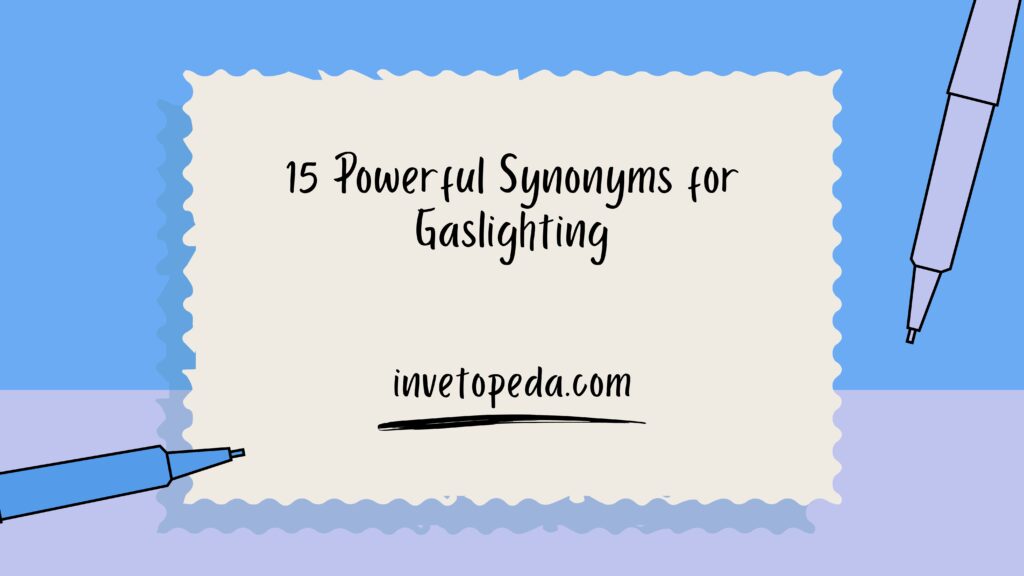Gaslighting has been among the top frequently talked about psychological terms in recent times. Based on the abuse of emotions and manipulative behaviour, Gaslighting can cause people to doubt their real-world reality, memories, or their sanity. The word is powerful however, there are a myriad of alternatives to gaslighting that offer deeper insight about this destructive behaviour. In this post, we’ll look at 15 powerful synonyms for gaslighting. Each has its unique particularity and function, which will help to recognize the effects of the emotional manipulation that takes place in many varieties.
1. Manipulation
Gaslighting is a deep-rooted form of manipulation. The practice involves manipulating facts and happenings to deceive another. The manipulation erodes the confidence of a person and slowly causes them to doubt their understanding of the world. In a partnership or at work, manipulating is an essential term used to describe gaslighting.
2. Deception
Gaslighting is a form of deceit that thrives off deceit. The gaslighter lies as well as omits the truth, and manipulates facts in order to obtain control over their emotions. By constantly deceiving people begin to wonder whether what they are hearing is true and what’s not. Deception and gaslighting are often associated with emotional violence.
3. Mind Games
Mind games are insidious but hazardous tools employed in gaslighting. Gaslighters can say something and then do the opposite and deny the obvious truth and play around with the emotions to frighten the target. The mind games that are played out by gaslighters are essential to the way gaslighting operates at both work and private environments.
4. Emotional Abuse
Gaslighting can be described as a type of abuse based on emotions. It’s not just about lying. It’s an ongoing attack on someone’s thinking as well as their emotions and self-worth. The abuse of emotions, such as gaslighting, is a long-term psychological affliction when left unresolved.
5. Psychological Manipulation
Psychological manipulation is the art of making smart and deliberate moves designed to affect the mind of someone. Gaslighting causes the victim to doubt their memories or emotions. This is the same as what gaslighters are aiming at.
6. Control
Control is the main purpose of gaslighting. Gaslighters want total control over the mind of the victim. The control is slowly built by using deceit as well as blame and guilt. The entire process of gaslighting has been created to make the victim feel vulnerable and uncertain.
7. Distortion
The gaslighting process involves distortion of facts, emotional or mental memories. They might make statements like “You’re imagining that,” or “That never happened.” As time passes, the person begins to believe these lies. This is a major way that gaslighters alter the reality.
8. Projection
Projection happens in an act where a person who is a gaslighter blames other people for the actions they’re taking their actions. In other words, they could blame their friend for having a lie or committing fraud while performing these very same things. The gaslighting process is often used in order to confuse and deceive.
9. Confusion
Confusion is among the main effects caused by gaslighting. People who suffer from gaslighting begin feeling confused, lost as well as mentally confused. The person who is the gaslighter causes this confusion with their constantly changing narratives or contradicting their own. The victim is left with a feeling of powerlessness.
10. Mind Control
When it is done seriously, gaslighting could be akin to mind control. In particular, in abusive relationships, gaslighters can isolate their victims and control every idea or choice. Gaslighting is a method of stripping away the victim’s persona.
11. Omission
The gaslighter’s voice isn’t always clear or clear. Sometimes, the person who lights does not provide the most important information or fails to provide crucial information. It creates confusion and causes the victim to blame the perpetrator. The act of omission to gaslight is subtle but potent.
12. Invalidation
Gaslighting is often a used technique. The gaslighter informs the victim that the victim that their emotions are false or exaggerated. Inspiring phrases such as “You’re overreacting” or “You’re imagining things” cause people to doubt their feelings, and that’s exactly the goal of the gaslighter.
13. Minimization
If you’re gaslighted then the perpetrator acts as if the incident didn’t really happen. But they’ll say things like “You are being overly sensitive” or “It was just a joke”. Gaslighting purposes the victim to feel embarrassed on his natural reaction to feeling awful.
14. Power Play
Gaslighting often is part of a larger game of power. It is a strategy used by those who do it to keep control of the situation by giving others the impression of being weak or overwhelmed. The gaslight technique is employed to rule both mentally and emotionally, particularly when they have already mastered the situation.
15. Mental Manipulation
Mental manipulation refers to each of the tactics that gaslighters use to control one’s thoughts. From deceit to psychological pressure, This word describes the ways in which gaslighters undermine the mental health of a person. Some victims don’t even know the damage is happening until it’s too late.

Conclusion
Gaslighting is an extremely serious type of controlling emotions. By learning these 15 terms–such as manipulation, deceit as well as projection and control, we are able to better comprehend the various ways that gaslighting manifests. Understanding these signs helps victims identify the source of gaslighting and move towards healing.
The act of gaslighting doesn’t happen as a singular incident; it’s an entire pattern of behaviour. It can be seen in family relationships, romantic interactions, or in the workplace the act causes lasting emotional damage. Recognizing its meanings provides us with the ability to recognize and respond to it.

